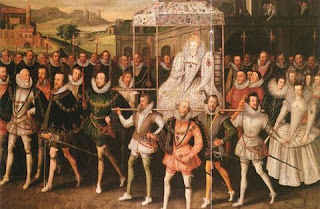HISTORY
OF ENGLISH LITERATURE
THE ELIZABETHAN PERIOD.
PROSE FICTION.
The period saw the beginning, among other things, of English
prose fiction of something like the later modern type. First appeared a series
of collections of short tales chiefly translated from Italian authors, to which
tales the Italian name ’novella’ (novel) was applied. Most of the separate
tales are crude or amateurish and have only historical interest, though as a
class they furnished the plots for many Elizabethan dramas, including several of
Shakspere’s. The most important collection was Painter’s ’Palace of Pleasure,’
in 1566. The earliest original, or partly original, English prose fictions to
appear were handbooks of morals and manners in story form, and here the
beginning was made by John Lyly, who is also of some importance in the history
of the Elizabethan drama. In 1578 Lyly, at the age of twenty—five, came from
Oxford to London, full of the enthusiasm of Renaissance learning, and evidently
determined to fix himself as a new and dazzling star in the literary sky. In
this ambition he achieved a remarkable and immediate success, by the
publication of a little book entitled ’Euphues and His Anatomie of Wit.’
’Euphues’ means ’the well—bred man,’ and though there is a slight action, the work
is mainly a series of moralizing disquisitions (mostly rearranged from Sir
Thomas North’s translation of ’The Dial of Princes’ of the Spaniard Guevara) on
love, religion, and conduct. Most influential, however, for the time—being, was
Lyly’s style, which is the most conspicuous English example of the later
Renaissance craze, then rampant throughout Western Europe, for refining and
beautifying the art of prose expression in a mincingly affected fashion.
In literature the imitations of ’Euphues’ which flourished
for a while gave way to a series of romances inaugurated by the ’Arcadia’ of
Sir Philip Sidney. Sidney’s brilliant position for a few years as the noblest
representative of chivalrous ideals in the intriguing Court of Elizabeth is a
matter of common fame, as is his death in 1586 at the age of thirty—two during
the siege of Zutphen in Holland. He wrote ’Arcadia’ for the amusement of his
sister, the Countess of Pembroke, during a period of enforced retirement
beginning in 1580, but the book was not published until ten years later. It is
a pastoral romance, in the general style of Italian and Spanish romances of the
earlier part of the century. The pastoral is the most artificial literary form
in modern fiction. It may be said to have begun in the third century B. C. with
the perfectly sincere poems of the Greek Theocritus, who gives genuine
expression to the life of actual Sicilian shepherds. But with successive Latin,
Medieval, and Renaissance writers in verse and prose the country characters and
setting had become mere disguises, sometimes allegorical, for the expression of
the very far from simple sentiments of the upper classes, and sometimes for
their partly genuine longing, the outgrowth of sophisticated weariness and
ennui, for rural naturalness. Sidney’s very complicated tale of adventures in
love and war, much longer than any of its successors, is by no means free from
artificiality, but it finely mirrors his own knightly spirit and remains a
permanent English classic. Among his followers were some of the better
hack—writers of the time, who were also among the minor dramatists and poets,
especially Robert Greene and Thomas Lodge. Lodge’s ’Rosalynde,’ also much
influenced by Lyly, is in itself a pretty story and is noteworthy as the
original of Shakspere’s ’As You Like It.’
Lastly, in the concluding decade of the sixteenth century,
came a series of realistic stories depicting chiefly, in more or less farcical
spirit, the life of the poorer classes. They belonged mostly to that class of
realistic fiction which is called picaresque, from the Spanish word ’picaro,’ a
rogue, because it began in Spain with the ’Lazarillo de Tormes’ of Diego de
Mendoza, in 1553, and because its heroes are knavish serving—boys or similar
characters whose unprincipled tricks and exploits formed the substance of the
stories. In Elizabethan England it produced nothing of individual note.
***Will be continued***












